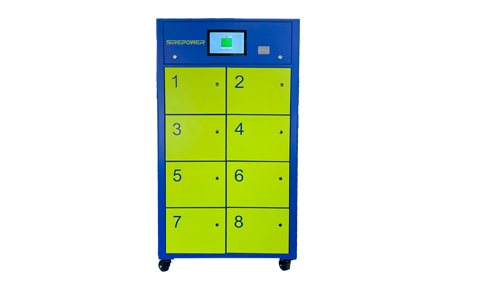How to manage 2/3 wheel electric vehicle charging stations?
(1) Concept definition
The charging facilities referred to in these Measures refer to various types of centralized charging stations and decentralized charging piles for electric vehicles, including ground structures of charging stations, power supply and distribution systems, charging equipment, monitoring and management systems, metering systems, protective facilities, ventilation and fire-fighting facilities, etc
01 Public Charging Facilities
It refers to charging facilities that are open to society and can provide charging services for various social vehicles.

02 Special charging facilities
It refers to charging facilities that provide charging services specifically for electric vehicles of a legal entity, non legal entity organization, and their employees, as well as charging facilities that provide charging services for all electric vehicles in residential areas.
03 Self use charging facilities
It refers to a charging facility that provides charging services specifically for a private user's electric vehicle.
How to manage electric vehicle charging stations?
(2) Regulatory body
The safety management of charging facilities shall be jointly supervised by the locality and the industry (field). Each town and street government shall include various charging facilities within its jurisdiction in the grid management scope of the town and street government and village (residential) committee where it is located.
The main responsibility for the safety of public and private charging facilities shall be jointly borne by the owner and the operating enterprise, and the safety supervision work shall be carried out by the local town and street governments and relevant competent departments according to their respective responsibilities; The main responsibility for the safety of self use charging facilities shall be borne by their owners.
If the owner of the charging facility entrusts a third party (including but not limited to operating enterprises and property management enterprises) to operate, maintain and manage the charging facility, a safety production management agreement must be signed, and both parties shall jointly bear the main responsibility for the safety production of the charging facility.
Owners of public and private charging facilities must comply with relevant national, industry, and local standards during the site selection, fire protection renovation, planning and design, and construction process of the charging facility.
For users who need to install their own charging facilities, the investment boundary point is the connection point of the charging facility line to the public power grid. The construction and operation scope of both parties is determined according to the ownership of the property rights. The power enterprise, together with the user or the entrusted electric vehicle sales enterprise and the site management party of the charging facility, will conduct a feasibility survey of electricity consumption and construction on site to determine whether the project has the construction conditions before construction can begin. The site management party of the charging facility should provide support and cooperation. After the completion of the charging facility construction, its S protection project shall comply with relevant national, industry, and local completion standards, and the completion acceptance data shall be retained for future reference.
Public and private charging facility operators must establish and improve safety management systems and production standards in accordance with current industry operating standards, set up safety management organizations, appoint full-time safety officers, and clarify safety responsibility persons for each operation link. The safety management system must include process monitoring, on-site management, hazard investigation, emergency response, publicity and training, and regularly carry out emergency training, drills, and evaluation and rectification.
06 Public use Specialized charging facility operators must provide safety production education and job skills training to their management and operation personnel, enabling them to master charging safety knowledge, electricity safety regulations, emergency response methods, etc., and conduct assessments on relevant personnel. Only those who pass the assessment can take up their posts.
07 Charging facility owners and operating companies must do a good job in the daily safety maintenance of charging facilities, strengthen the management of charging vehicles, strictly prohibit passengers in the vehicle during charging, and ensure that power distribution, charging, monitoring, fire protection, lightning protection and other equipment are intact. Charging facilities must cooperate with site safety reminders when they are in normal operation. For abandoned charging facilities that cannot provide charging services, charging facility owners and operating companies must promptly clean them up
The management party of the site where the charging facilities are located should carry out safety management of the charging facilities within the management area in accordance with the property service contract or agreement. During daily inspections of the site where the charging facilities are located, if any safety hazards are found, they must promptly inform the charging facility owner and operating enterprise, and urge them to eliminate the hazards in a timely manner; In case of emergency, measures such as turning off the power and emergency firefighting must be taken immediately.
09 Public and dedicated charging facility operators must establish enterprise level charging monitoring and video security monitoring systems. The charging monitoring system must monitor the operation and charging process of the charging facility, and issue an alarm when abnormal situations that endanger charging safety are detected (such as insulation monitoring abnormalities, high battery temperature, high voltage, excessive current, etc.). Public and dedicated charging facility construction or operation enterprises must promptly shut down the charging equipment and inspect the site. At the same time, the system must have data storage and management functions. Public and private charging facility operators should input real-time data on the operation of public and private charging facilities into the charging facility information management platform (hereinafter referred to as the municipal platform), and ensure the continuity and authenticity of the data. The municipal platform must cooperate with the Municipal Development and Reform Bureau to use the above data to carry out safety inspections of charging facilities throughout the city.
(3) Division of Regulatory Responsibilities
01 Town and Street Governments
Responsible for the safety supervision of charging facilities within the jurisdiction, and implementing the industry management responsibilities of relevant departments in the town and street, as well as the local grid management responsibilities of the town and street governments and village (neighborhood) committees.
02 Town and Street Related Departments
The relevant departments of the corresponding city shall guide and supervise the construction, operation, and safety of charging facilities according to their respective responsibilities, and conduct joint safety inspections during the grid connection acceptance process of power grid enterprises.
03 Municipal Development and Reform Department
Regularly organize third-party technical institutions to conduct safety spot checks on public and dedicated charging facilities throughout the city, and report the inspection results in writing to relevant town and street governments and competent departments. The relevant town and street governments and competent departments must urge the responsible parties for charging facility safety to rectify the safety hazards found in the inspection results within a specified period of time; Each town and street government, as well as the municipal supervisory department, shall strengthen the safety management of charging facilities within their respective responsibilities and carry out daily safety inspections, urging the responsible parties of charging facility safety to rectify the safety hazards discovered during inspections within a specified period of time.
(4) Accountability mechanism
01 For public and private charging facility operating enterprises that fail to correctly fulfill their safety work responsibilities under these measures, their respective town and street governments and relevant competent departments shall remind and interview their relevant responsible persons.
02 For public and private charging facility operating enterprises with significant accident hazards or failure to rectify within the prescribed time limit
The decision to stop using the charging facilities involved shall be made by the emergency management department and other departments responsible for safety production supervision and management. The operating enterprises of the public and private charging facilities involved shall implement it and promptly eliminate potential safety hazards. For those who refuse to comply with the decision to stop using, relevant units may be notified to stop power supply to the charging facilities involved and force them to comply with the decision. The notification should be in written form, and relevant units should cooperate.
According to the level of accidents caused by charging facilities resulting in casualties and property damage, the municipal emergency management department, fire rescue detachment, and the local town and street government will investigate and handle them separately. If safety accidents occur due to the failure to implement the main responsibility of safety, the legal responsibility of the personnel responsible for production safety accidents shall be pursued in accordance with laws and regulations; Those suspected of committing crimes shall be transferred to judicial authorities for handling in accordance with the law.
Hot Keywords:
ev fast charger manufacturers
best electric vehicle charging companies
Fast charging







 WhatsApp Contact
WhatsApp Contact